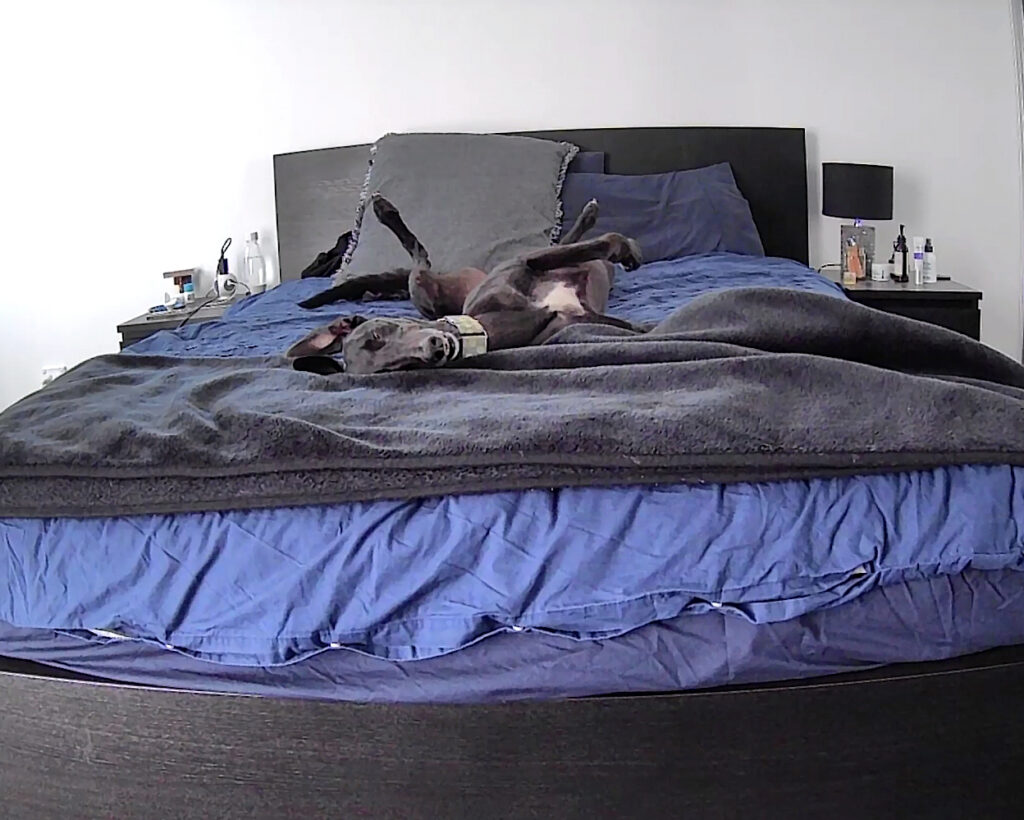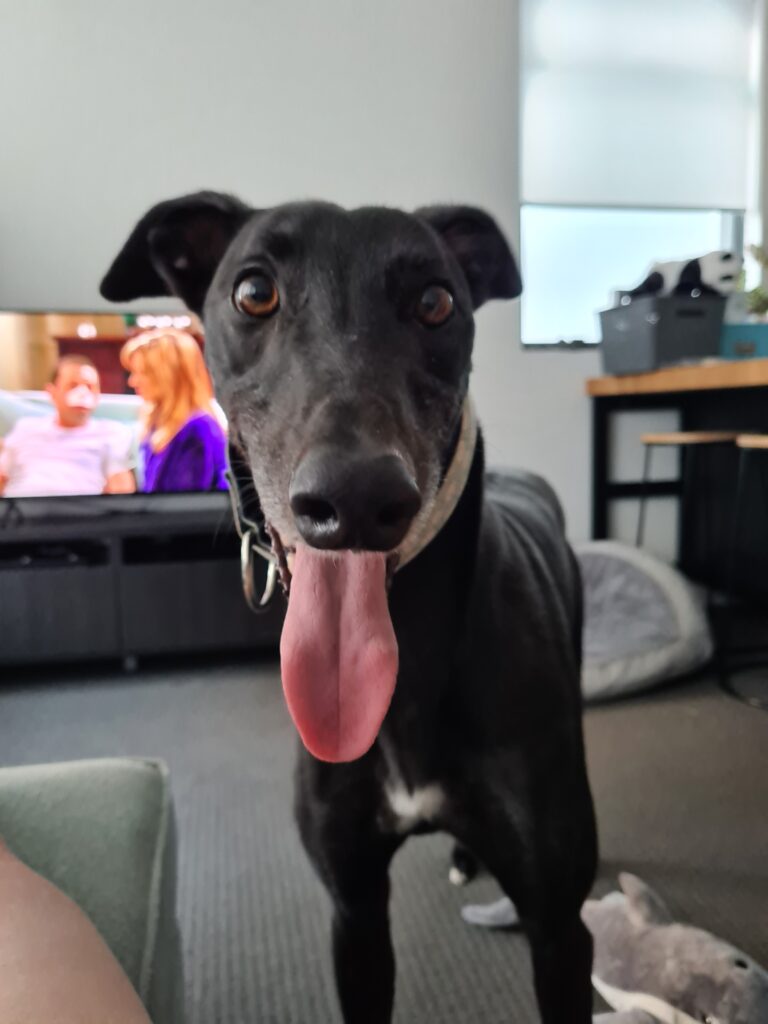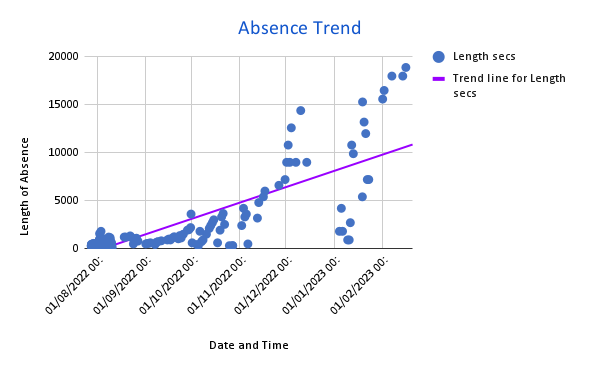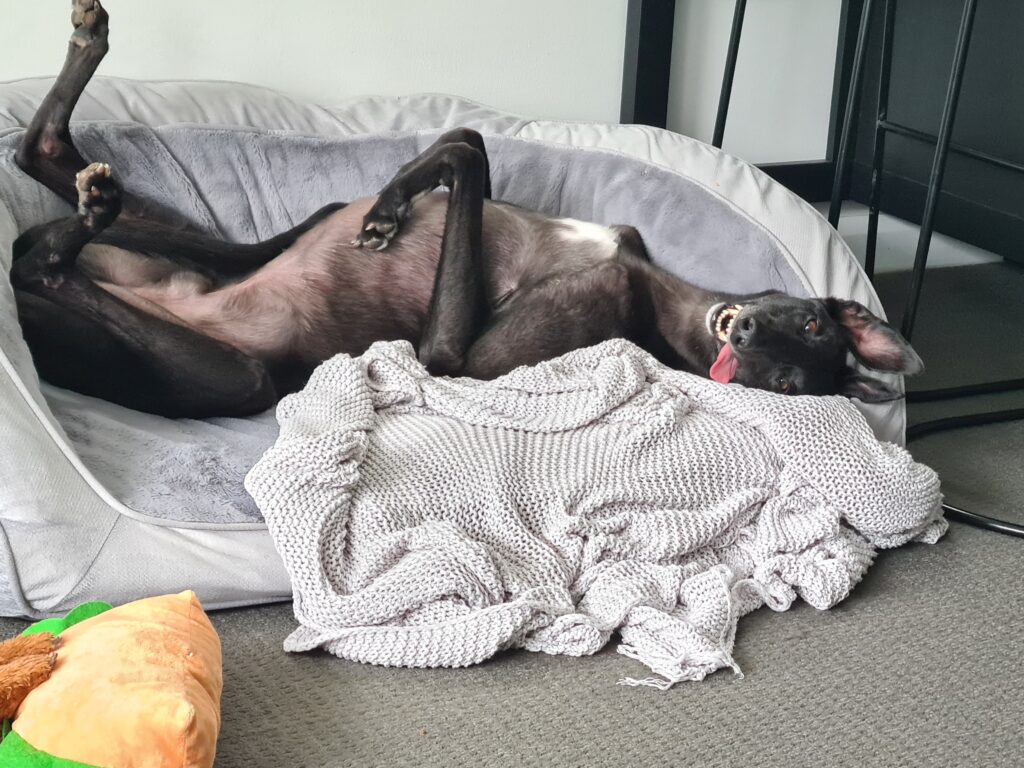The beautiful Finnigan started displaying signs of separation distress early in his journey into pet life with Taegan. Pacing, an inability to settle, frequent accidents… These were some of the signs that made it clear to Taegan something wasn’t right. Just over six months later Finnigan is making incredible improvements. Read on for a heartwarming story of love, perseverance and patience.

Early days
Before adopting Finnigan, Taegan had purchased a monitoring camera. This would prove to be the key in finding out how distressed he was when she wasn’t at home. Pacing back and forth from the front door to the lounge room, unable to settle, weeing and defecating inside – these were all signs for Taegan that something wasn’t quite right.
“Although it was still early days and he was still being toilet trained, the accidents happened more frequently when I wasn’t home,” explains Taegan.
“Then probably the third or fourth time I left him alone it escalated to vocalisation. He would start to cry and then constantly bark, and he wouldn’t stop until I came back inside. Then it would only take 30 seconds for him to start barking when I would leave.”
The Diagnosis
Taegan sought assistance from her Greyhound Rescue adoption coordinator, who suggested a vet visit. Armed with some videos of the behaviour, the vet diagnosed Finnigan with separation distress, and also prescribed some situational medicine for use when he had to be left alone.
Taegan’s Next Steps
Taegan says that while medication was a great help for Finnigan, it wasn’t a magic bullet.
“He needed more, so I decided to start separation anxiety training in conjunction with his medication,” says Taegan.
“I purchased Julie Naismith’s book “Be right Back” and it was an absolute saviour for us. I read it more than once, referred back to it whenever I got stuck, and listened to her podcasts. Her method is what really worked for us.”
Taegan says cameras are a must – if you can’t see their behaviour you won’t be able to spot the signs of stress, and abort a session before it escalates.
Tagean’s support network was so important in the early days. When she had to leave the house, she had a team of family and friends willing to help. Taegan also found great comfort in a Facebook support group, focussed on dogs with separation anxiety.
“It helps to know that you are not alone and that other people are going through the same thing as you” Taegan explains.
“It was really good for my mental health. You could ask advice, see what was working for other people, and see other people’s successes, which was very encouraging.”
With the most challenging part of their journey behind them, (which was approximately the first five months), Taegan is proud to announce that Finnigan can now handle over five hours alone. She engages a dog sitter when needed, and training sessions are fewer and further between. Taegan finds she doesn’t need to leave him alone much longer than what he can cope with, which she believes is a great problem to have.



An emotional experience
Taegan knows all too well how complex your emotions can be when dealing with a hound and their separation distress. The love, the frustration, the tears, the feelings that things would never improve. But it was Finnigan himself that kept her going, explaining that he gave her strength to continue working through his distress.
“He is just the sweetest, goofiest nutbag and I just wanted him to be happy and safe with me,” Taegan says. “I wanted to do everything I could to keep him here with me.”
“Whenever it came up in conversation, I had people minimise his condition or suggest I return him.”
“I couldn’t help but think of it as a possibility, but every time I did I couldn’t fathom it. If I couldn’t help him, then who? This was a challenge for me that I wanted to take on. I am so glad I did because I fall in love with him more and more everyday.”
Regressions were especially hard, and Taegan says that if this process has taught her anything it is patience.
Words of wisdom
Taegan encourages anyone going through separation distress to be kind to themselves, and to their hound.
“Separation distress is an emotional reaction that your houndie doesn’t have control over, it is an irrational fear.”
“When working through the training, regressions are almost guaranteed to happen, because just like us, your dog might just be having a bad day. Trying to change emotions is not a linear process, it is going to be up and down. If you prepare yourself to expect this to happen, the regressions are less devastating.”
To adoptees just starting out on their journey, Taegan says to remember that although it may not feel like it right now, it will get better. And when it does it is so rewarding.
“Every dog’s anxiety signs will vary, I had to become an expert in finding out Finni’s particular signs that he was starting to get upset,” Taegan says.
“This takes practice so don’t be too hard on yourself if you miss a sign and they go over threshold. You are both learning and mistakes will probably happen because the world is not perfect.
Taegan has a few suggestions that helped her through her journey with Finnigan:

- Plot your absence times on a scatter graph and add a trendline. This really helped Taegan see the bigger picture. Despite a bad day, or a bad week, Taegan could see the overall positive progress he was making.
- When it comes to SD Training, it’s a ‘go slow to go fast’ situation.
- Wholeheartedly celebrate the wins and milestones! When working so hard through something like this, Taegan’s heart would swell with pride when he had a successful session.
- Don’t be afraid to take a break if it feels too overwhelming – your hound might be picking up on that so it may be time you both had a break.
“The Greyhound Rescue Team were so wonderful supporting us along the way”, says Taegan.
“I had volunteers offering to help dog sit Finni or put me in touch with other people in the community who were willing to help ease the burden. I was really touched that I was receiving such generosity.”
“I would also post updates on Finni’s progress and was always met with encouragement and support. They would celebrate his wins with me, which was so important and helped keep me motivated to keep going with his training.”
A special bond
Taegan considers herself an optimist, a self-proclaimed ‘science nerd’, with compassion for animals and the environment. She had always wanted to adopt a greyhound, but never felt she was in the right living situation. But at 34, a life changing cancer diagnosis changed that.
“I was diagnosed with stage four bowel cancer at age 34” says Taegan.
“When you get a diagnosis like that you reflect on what you’ve done in your life and one of the things I thought about was never taking the steps to rescue a greyhound. Two major surgeries and 2 x 3 month stints of chemo later I was given the all clear, so that was when I decided I would finally do it.”
“I moved into a new place specifically so I could rescue a greyhound, and then came along Finni. I think going through what I went through probably really helped me see this through with Finni. Just as I didn’t give up when I was going through treatment, I wasn’t going to give up on him.”

Separation distress isn’t unique to greyhounds. In fact, it can affect any breed for a variety of reasons. And while there is no simple overnight fix, there are some steps we can take to help our hounds stay calm when home alone. You can find some steps on how to help your hound learn to be alone here.

